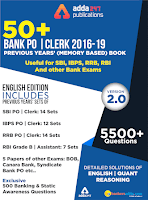Reasoning Questions for SBI CLERK Main 2019
Directions (1-5): Study the following information carefully and answer the questions given below:
P, Q, R, S, T, U and V are seven players, who play for the same team. In a match meeting, they all are sitting around a circular table facing to the center. Also each player has to complete his training, which is assigned to them. No two player can complete their training at the same time and no two adjacent player finish their training immediately one after the other.
P completes his training immediately before Q. R sits third to the left of S but completes his training after S. Q sits to the immediate left of V. T sits to the immediate left of the player, who completes his training before two players. U completes his training immediately after Q but not after R. The number of players who complete their training before V is same as the numbers of players, who complete their training after V. U sits 2nd to the right of person who completes his training 1st.
Q1. Who sits fourth to the right of Q?
The number of players who complete their training before V is same as the numbers of players, who complete their training after V. Hence V completes his training in 4th position. P completes his training immediately before Q. U completes his training immediately after Q but not after R. Hence P, Q, U completes his training in either 1st, 2nd, 3rd position respectively or in 5th, 6th, 7th position respectively. If U completes his training in 7th position, then R must be complete his training before U, which cannot be possible. So P, Q, U completes his training in 1st, 2nd, 3rd position respectively.
Also we try to complete circular arrangement from the given conditions; R sits third to the left of S but completes his training after S. Hence S completes his training before R. T sits to the immediate left of the player, who completes his training before two players (means 5th position player). No two adjacent player finish their training immediately one after the other. Hence S completes his training in 5th position. And T completes his training in 7th position and R completes his training in 6th position.
Q sits to the immediate left of V. Hence V sits either immediate left of R or second left of R. If V sits immediate left of R, then Either U or P sits immediate right of S, which is not possible. So V sits second to the left of R. And U sits immediate right of R. U sits 2nd to the right of person who completes his training 1st.
The final arrangement are-
Q2. How many players complete their training before P?
The number of players who complete their training before V is same as the numbers of players, who complete their training after V. Hence V completes his training in 4th position. P completes his training immediately before Q. U completes his training immediately after Q but not after R. Hence P, Q, U completes his training in either 1st, 2nd, 3rd position respectively or in 5th, 6th, 7th position respectively. If U completes his training in 7th position, then R must be complete his training before U, which cannot be possible. So P, Q, U completes his training in 1st, 2nd, 3rd position respectively.
Also we try to complete circular arrangement from the given conditions; R sits third to the left of S but completes his training after S. Hence S completes his training before R. T sits to the immediate left of the player, who completes his training before two players (means 5th position player). No two adjacent player finish their training immediately one after the other. Hence S completes his training in 5th position. And T completes his training in 7th position and R completes his training in 6th position.
Q sits to the immediate left of V. Hence V sits either immediate left of R or second left of R. If V sits immediate left of R, then Either U or P sits immediate right of S, which is not possible. So V sits second to the left of R. And U sits immediate right of R. U sits 2nd to the right of person who completes his training 1st.
The final arrangement are-
Q3. Which of the following is the seating order in anticlock-wise direction from point S(Including S)?
The number of players who complete their training before V is same as the numbers of players, who complete their training after V. Hence V completes his training in 4th position. P completes his training immediately before Q. U completes his training immediately after Q but not after R. Hence P, Q, U completes his training in either 1st, 2nd, 3rd position respectively or in 5th, 6th, 7th position respectively. If U completes his training in 7th position, then R must be complete his training before U, which cannot be possible. So P, Q, U completes his training in 1st, 2nd, 3rd position respectively.
Also we try to complete circular arrangement from the given conditions; R sits third to the left of S but completes his training after S. Hence S completes his training before R. T sits to the immediate left of the player, who completes his training before two players (means 5th position player). No two adjacent player finish their training immediately one after the other. Hence S completes his training in 5th position. And T completes his training in 7th position and R completes his training in 6th position.
Q sits to the immediate left of V. Hence V sits either immediate left of R or second left of R. If V sits immediate left of R, then Either U or P sits immediate right of S, which is not possible. So V sits second to the left of R. And U sits immediate right of R. U sits 2nd to the right of person who completes his training 1st.
The final arrangement are-
Q4. Who completes his training immediately after R?
The number of players who complete their training before V is same as the numbers of players, who complete their training after V. Hence V completes his training in 4th position. P completes his training immediately before Q. U completes his training immediately after Q but not after R. Hence P, Q, U completes his training in either 1st, 2nd, 3rd position respectively or in 5th, 6th, 7th position respectively. If U completes his training in 7th position, then R must be complete his training before U, which cannot be possible. So P, Q, U completes his training in 1st, 2nd, 3rd position respectively.
Also we try to complete circular arrangement from the given conditions; R sits third to the left of S but completes his training after S. Hence S completes his training before R. T sits to the immediate left of the player, who completes his training before two players (means 5th position player). No two adjacent player finish their training immediately one after the other. Hence S completes his training in 5th position. And T completes his training in 7th position and R completes his training in 6th position.
Q sits to the immediate left of V. Hence V sits either immediate left of R or second left of R. If V sits immediate left of R, then Either U or P sits immediate right of S, which is not possible. So V sits second to the left of R. And U sits immediate right of R. U sits 2nd to the right of person who completes his training 1st.
The final arrangement are-
Q5. Who among the following sits to the immediate right of S?
The number of players who complete their training before V is same as the numbers of players, who complete their training after V. Hence V completes his training in 4th position. P completes his training immediately before Q. U completes his training immediately after Q but not after R. Hence P, Q, U completes his training in either 1st, 2nd, 3rd position respectively or in 5th, 6th, 7th position respectively. If U completes his training in 7th position, then R must be complete his training before U, which cannot be possible. So P, Q, U completes his training in 1st, 2nd, 3rd position respectively.
Also we try to complete circular arrangement from the given conditions; R sits third to the left of S but completes his training after S. Hence S completes his training before R. T sits to the immediate left of the player, who completes his training before two players (means 5th position player). No two adjacent player finish their training immediately one after the other. Hence S completes his training in 5th position. And T completes his training in 7th position and R completes his training in 6th position.
Q sits to the immediate left of V. Hence V sits either immediate left of R or second left of R. If V sits immediate left of R, then Either U or P sits immediate right of S, which is not possible. So V sits second to the left of R. And U sits immediate right of R. U sits 2nd to the right of person who completes his training 1st.
The final arrangement are-
Directions (6-10): Each of the questions below consists of a question and two statements numbered I and II given below it. You have to decide whether the data provided in the statements are sufficient to answer the question.
Q6. Who is to the immediate right of G among seven persons E, F, G, H, I, J and K facing inside?
I. I sits third to the left of H and G is second to the left of I. The person, who sits third to the right of G, is third to the left of E.
II. F sits fourth left of the person, who sits immediate right of E. H is to the immediate right of K.
Q7. In a family of seven people, how is K related to Z?
I. X is brother of S and Y is sister of S, who is unmarried person of the family. Z is married to Y.
II. S's mother is married to R's husband, who has one son and two daughters. T is daughter-in-law of K’s wife.
Q8. Among five persons namely P, Q, R, S and T. Who is the tallest?
I. S is taller than T, P and R but not as tall as Q.
II. S is taller than R but not as tall as Q, who is taller than T.
Q9. Among A, B, C, D and E whose salary is the highest?
I. Combined salary of A and B is more than the combined salary of C and D but E's salary is more than A's and B's.
II. Difference between A's salary and C's salary is more than the difference between D's and B's salaries where A's salary and D's salary are higher than C's and B's respectively.
From II, Salary of (A-C) > Salary of (D-B); Salary of A > Salary of C and D > B
From I and II, we get salary of E > salary of A,B or C. But we still do not know among D and E whose salary is the highest.
Q10. How many children does Mr X has?
I. Mr X has eight sons and each has one sister.
II. Number of sons of Mr X is eight times the number of his daughter(s).
Q11. Statement: Renowned Malayalam author KP Ramanunni lodged a police complaint regarding an anonymous threat letter warning him that his right arm and left leg would be chopped off if he did not convert to Islam within six months.
Which of the following abrogates the statement?
(i) The threat letter was sent to Mr Ramanunni's Kozhikode residence six days ago.
(ii) The writer said though there was no indication as who was behind the letter.
(iii) Mr Ramanunni said though he had ignored the letter initially, other senior writers advised him to file the police complaint.
we have to choose an option which negates the statement.
not negates the statement, it substantiates that a letter was indeed sent to
Mr. Ramanunni.
not negates the statement, it simply gives an additional detail about the
incident.
Option (iii) does not negates the statement, it
substantiates that a letter was indeed sent to Mr. Ramanunni.
Q12. Statement: A newspaper report -“The Muslim man with a forbidden job”. Mohammad Lahham is a sculptor in Lebanon who fled the war in Syria five years ago with his wife, two children and his parents.
Which of the following can be hypothesized from the above statement?
(i) Mohammad Lahhaml creates sculptures of Christian saints whereas Islamic tradition discourages the depictions of deities in physical form.
(ii) Mohammad Lahham is an illegal immigrant in American subcontinent.
(iii) Mohammad ran away from the danger and therefore his return to Syria is forbidden.
we have to choose an option which can be hypothesized from the facts given in
the statement.
hypothesized from the statement as his religion is clearly mentioned in the
title of the report which means that it might have something to do with
religion.
wrong statement as Lebanon is not a part of American subcontinent.
Option (iii) is not a correct choice as its his
job that is being referred to as forbidden in the statement
Directions (13-15): Read the following information carefully and answer the following questions.
There are eight members A, B, C, D, E, F, G and H of the same family. F, D and E are the only females’ members. D, who is married to B, is the second youngest member. Both H and C, are E’s maternal uncle. A, who is the only child of G, has three kids. All the females belong to a different generation. F has only one child.
Q13. How is A related to E, if it is given that E is the only unmarried female and F is the oldest member in the family?
Q14. How many persons are older than A’s son in law, if it is given that E is the only unmarried female and F is the oldest member in the family?
Q15. How is F related to C?
- Check the Study related Articles Here
- Study Notes for All Banking Exams 2018
- Bankers Adda Daily Questions for SBI PO, IBPS PO Clerk & Bank Exams




 The Hindu Review October 2022: Download ...
The Hindu Review October 2022: Download ...
 SBI SO Salary 2024, Salary Structure, Pe...
SBI SO Salary 2024, Salary Structure, Pe...
 SBI Clerk Previous Year Question Paper P...
SBI Clerk Previous Year Question Paper P...



